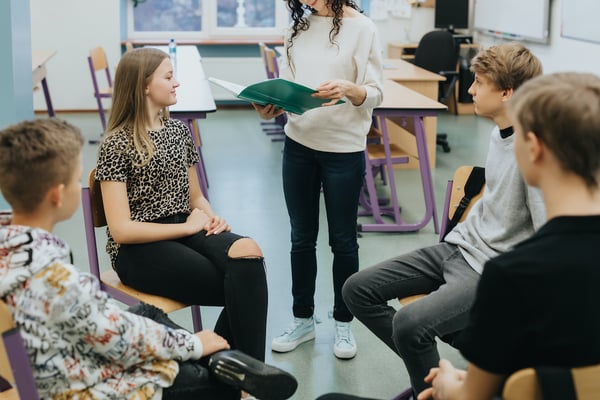1 April 2022
5 ways to prepare your middle schoolers for high school success
Dr Anna Bean
Educator Success Specialist, Digital Theatre+
It’s often said that Middle School is a type of hell for students. As educators who spend 8 hours+ a day with middle schoolers, we witness the challenging mental and physical movement from child to young adult. Our primary responsibility lies in preparing them for feeling successful in high school. How can we help with these challenges?
1. Independent learning
Independent learning is more achievable with the advent of web-based learning, designed-for-school laptops, and mobile phone use in the classroom. With some headphones, students can even form a self-guided learning pod. The main difficulty with this approach is keeping students on task and away from Internet distractions. It is extremely difficult to monitor the online activity of a classroom of 30 (even 10!) students, so teaching middle schoolers how to work independently is crucial.
One method I’ve had success with is to have students work in 10-minute increments with 1-minute short breaks and 3-minute long breaks. I based this idea on the Pomodoro Technique. I would project a slide that would break down the day’s lesson into chunked tasks. You could break down the lesson into as many chunks as necessary for each student. I would touch base with my students during the lesson to let them know their individualized adaptations. The key is that during the 10-minute chunk, the student worked on one task and one task only. No social media checking and, also, no skipping ahead to the next task. They had to use the full 10 minutes, even if they finished writing earlier than that. Eventually, the students would work independently on the assigned task (writing or revising but never writing AND revising) for those entire 10 minutes, with the motivating factors of a short (1 minute) or long break (3 minutes) coming up soon.
2. Collaboration in the classroom
Middle school students will more readily collaborate than high schoolers. By the time they reach high school, many students react badly when the teacher says: “Let’s do some group work.” Some will mimic choking and gagging, others will silently plead to me with their eyes…please, please don’t make me do this. I’ve always tried to use enjoyable collaborative projects as much as possible with middle schoolers, so they can go onto high school with positive experiences. Here are some of the tips I’ve picked up.
- Know your students: I avoid group work for the first month of a school year, give or take. By then they and I know each other as individuals in that particular class. This helps to make an informed decision when picking collaborative groups. Make the project fun as well as compelling. Collaborative learning needs to be enjoyable for students. Boring activities breed bad collaborations, and can even feed antisocial behavior.
- Assign different roles: each student should have a role in the group. There are many group work models out there online. What they all have in common is that they are meaningful and interdependent – the group cannot complete the project without every role fulfilled.
When my middle schoolers go to high school, it’s likely that their group work experiences will not be the same as they were in my classroom. All we can do is arm them with the knowledge that collaborative work leads to something that is always better than the sum of its parts.

3. Homework habits
During school: If you can, put time aside for students to begin their homework in class. There is no substitute for having a teacher immediately available to explain the instructions or help students when they are stuck. The key to having in-class work time be productive is to tell the students when the assignment is given the times you have set aside to work on it. Middle school students rarely have study halls, free time, or flex blocks; however, these are common in high school. Establishing good in-school homework practices in middle school will benefit those students in high school, when they have a lot more independent study time.
Out of school: Once the bell rings (or, in my last school, a ‘70s disco hit is played over the intercom system!), students still have many hours before they sleep. During that time, they might have sports or play practices, music or dance lessons. They may also have an hour-long bus ride or have to wait for a few hours until an adult can pick them up. Once they arrive home, some are tasked with caring for their younger siblings and making dinner. Or they have an after-school job. Many students have several scheduled after-school activities every day. Homework doesn’t always get priority. By the time the student does get alone time, they understandably want to unwind with social media. Here are my tips when working with parents/guardians and students to establish good homework habits.
First, the student needs a sacred time each day, Sundays through Thursdays, to do homework. The key is to have this sacred homework time agreed by the adults and the student for each day, as schedules for each day can change.
Second, when the student is doing work at home, they need to do it in a public place. Since many parents also work during the evening hours, try suggesting that they work in the same room as the student. In my home, we worked collectively at the kitchen table with laptops open, snacks and drinks, actively chattering about what each of us was working on. The true spirit of working together is that you all learn about each other’s life through voicing minor frustrations, telling funny stories, and even through helping each other with tasks. Once my children went to college, I deeply missed these times we spent working through the necessary stuff of our lives together.
4. Expressing true selves
Middle schoolers shine in the most unexpected ways. The quietest ones blossomed in my Public Speaking classes when they delivered a presidential inaugural address, becoming Lincoln, Reagan, or Kennedy. In these moments, I saw hopeful inklings of the adult this student could become. I also realized that some students shine in non-speaking ways, such as designing a poster for the musical or playing a difficult jazz solo in the band. These middle schoolers were bravely revealing what they loved, cared about, and worked on to teachers and to each other. They were expressing their true selves, and as their teacher, I made sure that they knew that this would be an asset when they were in high school, not a burden.
5. Practicing self-care
My previous school returned to in-person learning ahead of many schools in the Northeast last year. We were surrounded by kids who were fearful and hyper-aware of every interaction while desperate for real contact with people outside of their COVID pod. To calm their unfocused energy, I began all three sections of Middle School Drama with students lying on the floor with eyes closed, while I led them through a bodily check-in (tense and release muscles in every region of the body) and a visualization of their most peaceful place. Even though we had to break back into the real world when the activity was done because each student had to disinfect their space, the sense of calm carried into the rest of the class time. This routine quickly became a necessary aspect of class during the 2020-21 school year.
With summer approaching, I contacted parents and explained what we had been doing in class, asking them to talk with their student about the self-care routine and to encourage the child to continue the exercises at home. I hope that some students carried over the activity to their home lives or their lives beyond middle school. Seeing their parents and teachers working together is an essential way to model an example of real collaboration for our students.
Given the extraordinary middle school years our students experienced from 2020-2022, equipping students with the five best practices I’ve outlined above is, in my mind, essential. Middle schoolers are more likely to feel empowered to think critically, communicate, create, and collaborate (crucial 21st-century skills!) if all the adults in their lives help them with this exciting new stage in their education.
Related blogs
How to Prepare for Back-to-School Season
From putting the finishing touches on your classroom decor, to getting back into the professional...
Read moreMaking Shakespeare Fun: 5 activities for your middle schoolers
Teaching Shakespeare and tired of hearing groans and seeing eye rolls whenever you mention him in...
Read more5 fun drama games for your middle schoolers!
These practical theatre games are the ultimate antidote to a morning of desk-sitting blues! Plus,...
Read moreGet the latest teaching tips straight to your inbox
Explore free lesson ideas and inspiration, education news, teaching trends and much more by signing up to regular blog updates!





.jpg)